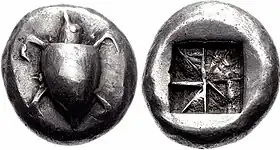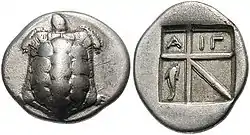Silver staters of Aegina

Silver stater of Aegina, 550–530 BC. Obv. Sea turtle with large pellets down center. Rev. incuse square with eight sections. After the end of the Peloponnesian War, 404 BC, Sea turtle was replaced by the land tortoise.
The Coinage of Aegina began in the 6th century BC. The front has a sea turtle design, while the back has a punch mark, found on most coins at that time. The earliest coins were made of electrum, a mix of gold and silver. The coins were first made in the island of Aegina, off the southeast side of Greece.
Yale Professor and Historian Donald Kagan sustains that the king of Argos Pheidon was "the first man to strike silver coins on the island of Aegina" in the 7th century, however this has been contested by most experts in the field and so far unconfirmed by archeological evidence.[1]
The coins with 'turtle' design are considered "an important early trading currency".[2]
See also
References
- ↑ Kagan, Donald (2008-11-20), "8. Sparta", Introduction to Ancient Greek History (CLCV 205) Lecture 8. Sparta, retrieved 2023-12-29
{{citation}}: CS1 maint: url-status (link) - ↑ "Silver stater, with a turtle". The British Museum. Archived from the original on 30 April 2011. Retrieved 12 April 2011.
This article is issued from Wikipedia. The text is licensed under Creative Commons - Attribution - Sharealike. Additional terms may apply for the media files.
